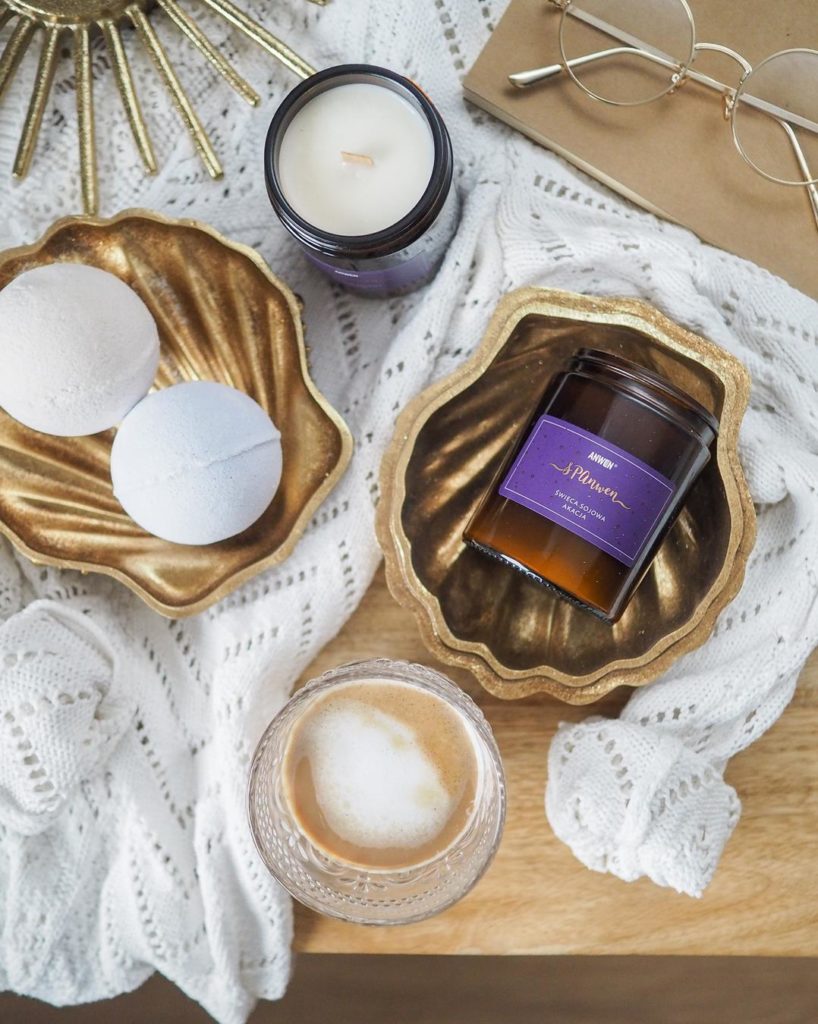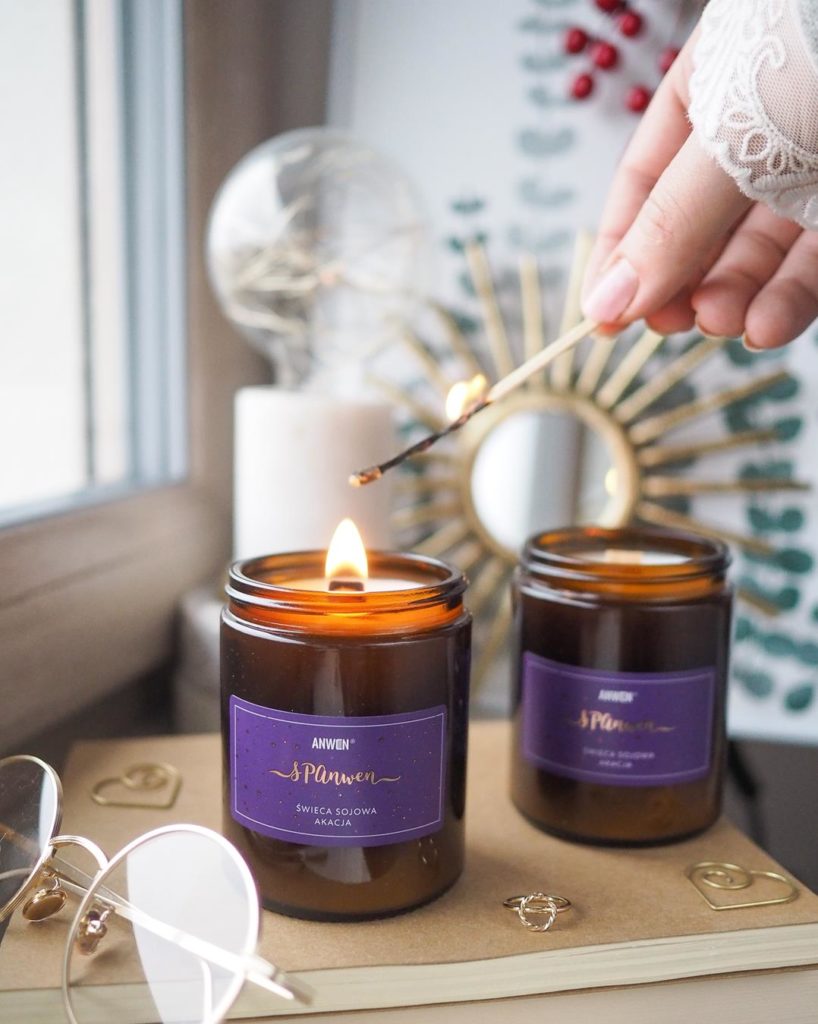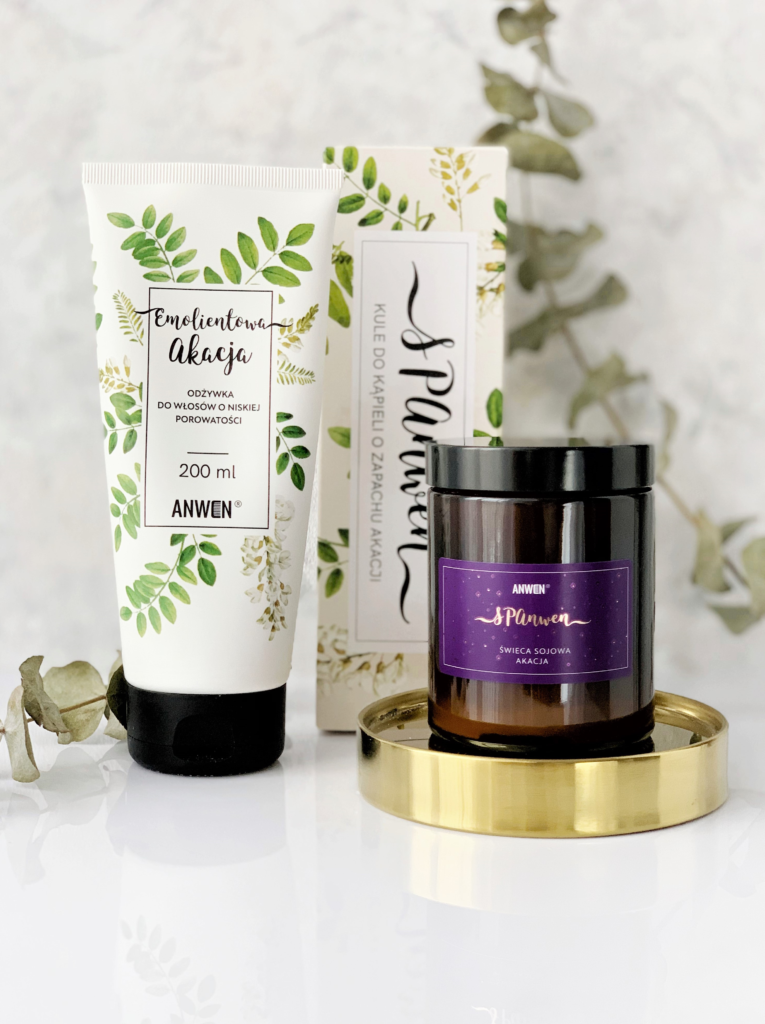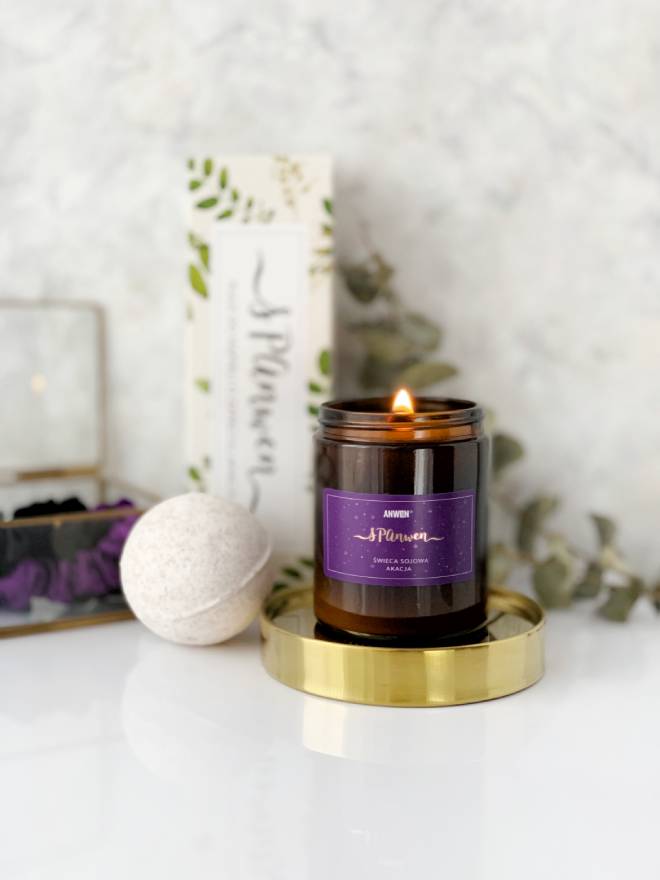Let acacia spoil you!
Our clients inspired us to create Anwen candles. Their acacia scent perfectly goes with the bath bombs of the same fragrance and harmonizes with the whole line of Anwen products. Environmental responsibility and #lesswasteful approach have been a priority to us also when making candles. So, what are safe candles? And how are Anwen’s soy candles made?
Safe wax!
Candle waxes have been widely discussed in numerous articles. However, it is difficult to talk about one type of soy wax. A few years ago, soy waxes entered the market with a whole range of plant-based candle waxes as an eco-friendly alternative to the paraffin widely used in the candle manufacturing process.
Soy wax instead of paraffin? It sounds great. But the substitution turns out not to be so simple. Commonly used soy waxes are what is called partially hydrogenated soybean oil. A fully hydrogenated oil would be difficult to use in candle making. Therefore, different substances are added to plant-based waxes (including soy waxes) to modify their properties, including melting (at a lower temperature to prevent the glass jars and ceramic containers from cracking), coagulation, and crystallization. You can find more about this in a scientific study [1]. The added components of the wax should also be taken into consideration when considering the safety of candles.
Why does wax composition matter? First of all, candles are generally used indoors. With poor ventilation, the toxic substances added to the wax can escape in the process of burning, causing damage to both people and the environment. The particulates released during combustion can be especially harmful to the respiratory system and contribute to asthma and possibly even lung cancer [2]. Also, the burning of candles produces volatile compounds equally dangerous to humans, including formaldehyde and acetaldehyde, which are considered hazardous. Not all ingredients added to the wax and the used fragrance compositions are safe. You can read more about the risks of using harmful substances in candles in an interesting article on the Molecule blog [3].
It is essential to pay attention to both the type of wax and the added ingredients. It turns out that plant-based waxes promoted as “ecological” due to the components may be dangerous as well as paraffin, a by-product of petroleum, releases cancer-causing soot while heating and burning [4].
Burn candles! In a right way
When we buy a candle, we are not always 100% sure of the origin of all added ingredients. It is essential to follow the safety rules for burning candles developed by the European Candle Association:
- use only high-quality candles made of safe ingredients
- burn candles in a place with no drafts. The quiet place ensures a soot-free burning.
- burn candles in appropriate candle holders or original containers. Correctly matched containers and wick sizes are essential for safe and long-lasting candle burning.
- cut the wick. Depending on the type of candle, the wick should remain 10-15 mm above the surface of the wax
- do not blow out the candle flame
- ventilate the space after burning the candle.
Don't give up on candles! Use them consciously
Despite the hazards of scented candles, they are still trendy. And no wonder. Candles create a fantastic atmosphere, allowing for relaxing after a hard day and provide a beautiful scent. Their beautiful packagings and design fit perfectly with any interior. Candles’ universality makes them a perfect souvenir. After all, who doesn’t like candles? So let’s use them! Surround yourself with your favorite scent and enjoy the beauty of candles. Still, make sure the candles are safe for you and the environment.



That's what Anwen candles are!
Safe, organic soy wax!
In our candles, we only use wax from a reliable source. It is an organic, vegan soy wax that originates from Brazil. The wax is a by-product of soybean cultivation, certified by Eurofins Food Safety Solutions Limited as non-GMO. Its melting point is approx. 47-54 °C, which allows the candles to burn slowly. It is also free of petroleum and its derivatives, herbicides, pesticides, and toxins. The wax burns 50% slower than paraffin, and the scent lasts longer. Candles made of soy wax produce 90% less carbon dioxide than those made of paraffin.
Wooden wicks!
While cotton wicks are ok too, the vibe of wooden, eco-friendly wicks is beyond comparison. And that characteristic crackling sound… A wooden wick and an adequately matched size candle container guarantee a long burning time. If you expect a distinct and taller candle flame, decide on candles with a cotton wick. Wood wicks smolder rather than burn. The flame is low, barely visible. But this type of wick melts the wax evenly and lets the aroma release slowly. The double wicks used in our candles soak up the wax generously, eliminating the need to use flame retention enhancers.
The scent – gorgeous acacia
First of Anwen candles smells of acacia. It could not be otherwise. Acacia brings back delicate, summery scents that are beloved by our clients. Although the acacia scent is subtle, be careful when using the Anwen candle. The fragrance composition of 11% gives a very intense scent. We recommend burning the candle for 2-3 hours. It is enough for the aroma to develop and stay indoors for several hours. The scent added to Anwen’s candles is entirely safe. The same scent, in a significantly reduced proportion, is used in our acacia-scented conditioners. The fragrance composition is non-toxic and free of potentially allergenic substances. It also meets the requirements of Regulation (EC) No 1272/2008 and is certified by IFRA – The International Fragrance Association.
The minimalistic glass jars
For our candles, we use the same glass packaging as we use for our hair masks. The minimalistic jars we chose are of dark glass. Just like our masks, the candles have a capacity of 180 ml, which allows for a long burning time. The glass packaging of Anwen’s cosmetics was another step towards #lesswaste. We decided to use them while designing our candles. Glass packaging has several advantages that you can read about here. The jars are durable, withstanding over 50 hours of candle burning time. And the wick’s width, adequately matched to the jar diameter, makes them safe and prevents cracking while burning. An additional benefit is the ability to reuse the jar after burning. On top of that, aren’t minimalist jars with a subtle label just charming? They perfectly match in minimalist interiors. They will make every bathroom a real spa.
Candle burning guide. Yes, this manual is worth reading
Every SpaAnwen candle is packed with a cardboard box with a burning instruction. You should not underestimate the way candles burn. It is nothing new for candle fans who have tested other natural candles and know how to burn them properly. Due to the ecological wax and wooden wick, the candles require special treatment. Remember the three fundamental rules of candle burning: 1) the burning time, 2) the wick trimming, and 3) the proper extinguishing of the candle. The candle should burn long enough to let the top layer of wax melt over the entire surface. This process allows the scent to develop and prevents tunneling. Each time you use a candle, be sure to trim the wick to about 0.5 cm. With this simple step, the flame will burn evenly. Do not blow out the candle! Extinguish the candle by blocking the airflow, e.g., using the lid of a jar.
Our candles are entirely handmade and manufactured in Poland.
We hope that the acacia SpaAnwen candle meets your expectations and settles in your home spa.
Anwen Team
Sources:
[1] Rezaei, K., Wang, T. & Johnson, L.A. Hydrogenated vegetable oils as candle wax. J Amer Oil Chem Soc 79, 1241–1247 (2002). https://doi.org/10.1007/s11746-002-0634-z
[2] M.Lee, 2017, Candles Causing Cancer, Submitted as coursework for PH240, Stanford University, Fall 2016, http://large.stanford.edu/courses/2016/ph240/lee-m2/ (2.04.2021).
[3] Are Candles Bad for You? From Scented to Unscented, Molekule Blog, https://molekule.science/are-candles-bad-for-you-from-scented-to-unscented/ (2.04.2021).
[4] Frequent use of certain candles produces unwanted chemicals, Monday, August 24, 2009 https://www.scsu.edu/news_article.aspx?news_id=832 (2.04.2021).

